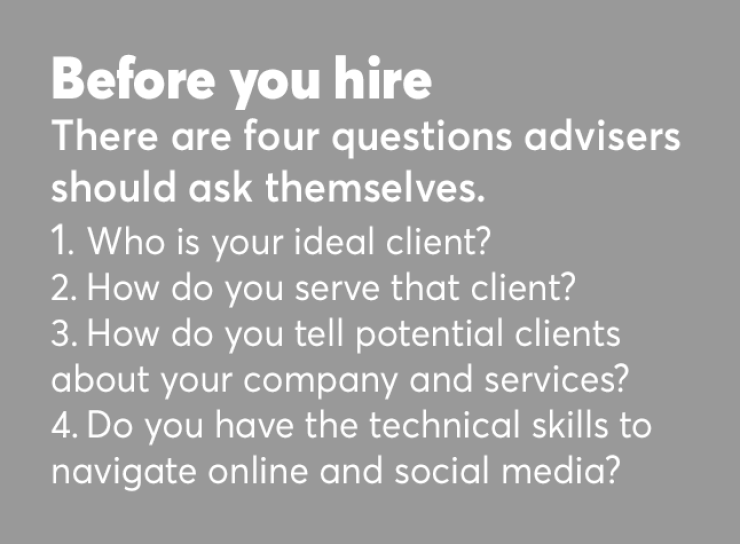In 2010, Dana Anspach, founder and CEO of Sensible Money in Scottsdale, Arizona, started working with a branding coach to identify foundational brand values for her business. “I spent less than $2,000, and it was a good purchase,” Anspach says.
On the heels of that success, Anspach hired a marketing expert. “He said, ‘When we’re done, the phones will ring,’” Anspach says. “I said, ‘My business doesn’t work that way.’ But he was right.”
Anspach’s firm has gone from handling $33 million in assets under management at the end of 2011 to $115 million at the end of 2016. Her website, which had garnered 10 client inquiries each year before the marketer went to work, now brings in 100 to 120 potential clients annually.
“The majority are qualified for my services,” she says. “We do retirement income planning and the majority of people who come in want exactly that. The website helps weed out people who are looking for something that we don’t offer.”
The difference, she says, was in changing a static website to one fitted with lots of things for viewers to do: watch a video, fill out a questionnaire, sign up for Anspach’s newsletter or download a free article. “Doing those things leads people to getting in touch,” Anspach says.
In the first year, Anspach spent $50,000 to $75,000 for a custom website and other associated marketing services. The marketing firm hosts the site and handles maintenance and updates, for which Anspach pays about $5,000 a year.
AN INITIAL STUMBLE
The financial outlay was a little lower for Vincent Barbera, managing partner at Newbridge Wealth Management in Berwyn, Pennsylvania. He also saw good results from the marketing team he ultimately settled on.
Before starting Newbridge three years ago, Barbera worked at a fee-based RIA with a marketing staff. “Having people always available worked well, but the disadvantage was that the person was on staff, so their insight was somewhat limited,” he says. “They just knew the Raymond James world.”

At Newbridge, he initially worked with an outside firm without much financial services experience. It charged $600 a month and turned out to be “a big mistake,” Barbera says. “They had us co-sponsoring club boxes at the NHL draft or the opening of a new frozen yogurt store” — tactics that just didn’t work to bring in new clients.
The marketing group that Barbera ultimately hired asked a lot of questions. “Our first call was a strategy call,” he says. “Who are we? How do we serve people? Who are we currently serving? What provides the most value? Who is the ideal client? Who do we want more of and how will we go get that person? If we’d started with that three years ago, we would probably be further along with the business.”
The new firm assigned Barbera homework. “We took a couple of clients out to lunch and asked them about what they value. What are their problems? What differentiated us as a fee-only RIA versus a wirehouse?” Barbera says. “We found out that they wanted a partner, someone who is available and can explain things.”

Ultimately, the marketing firm helped Newbridge define the clients it wants to serve. “Our ideal clients are midlevel executives who have been in the corporate world for 15 to 20 years,” Barbera says. “They would love to get out of that world, but a lot is resting on their shoulders: college costs, retirements. We help them develop a plan that lets them out of that world while still staying comfortable.”
His experience suggests that a planning firm might spend $5,000 to $10,000 to engage a small marketing firm and $30,000 to $40,000 to hire a larger company.
Barbera says that the expense has definitely been worthwhile. “I’ve seen my thinking really get more creative, and I’m more willing and confident about saying ‘no’ to clients who aren’t right for us,” he says. “I’ve stopped seeing saying ‘no’ as a loss and started seeing it as leaving room for a gain.”
ON-STAFF SPECIALIST
An on-staff marketing person is the option that Peter Creedon, founder and CEO of Crystal Brook Advisors in Mount Sinai, New York, took when he hired someone about a year ago. “Her job is to get the name of the company out there with the image that I want portrayed,” says Creedon, who already has strong opinions about his firm’s values and focus.
“I brought on a person to market to help me with the website and social medial aspects of marketing,” he continues. “I need to present my company and what I do in today’s media. I don’t have the technical expertise to deal with online marketing, and I need a web presence that makes sense to the people I’m trying to market to.”
The return on investment hasn’t been immediate, Creedon says, but “it’s kind of early — the website is still being revised. I’d love instant gratification and a hundred people pounding on my door, but it doesn’t work that way. This is an investment over time.”





